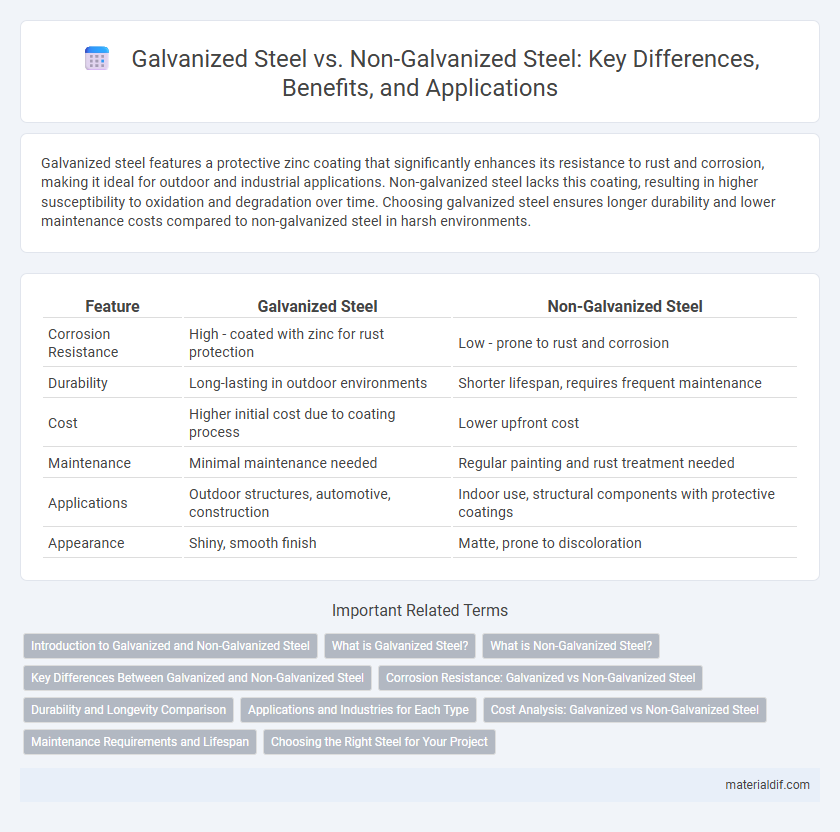Galvanized steel features a protective zinc coating that significantly enhances its resistance to rust and corrosion, making it ideal for outdoor and industrial applications. Non-galvanized steel lacks this coating, resulting in higher susceptibility to oxidation and degradation over time. Choosing galvanized steel ensures longer durability and lower maintenance costs compared to non-galvanized steel in harsh environments.
Table of Comparison
| Feature | Galvanized Steel | Non-Galvanized Steel |
|---|---|---|
| Corrosion Resistance | High - coated with zinc for rust protection | Low - prone to rust and corrosion |
| Durability | Long-lasting in outdoor environments | Shorter lifespan, requires frequent maintenance |
| Cost | Higher initial cost due to coating process | Lower upfront cost |
| Maintenance | Minimal maintenance needed | Regular painting and rust treatment needed |
| Applications | Outdoor structures, automotive, construction | Indoor use, structural components with protective coatings |
| Appearance | Shiny, smooth finish | Matte, prone to discoloration |
Introduction to Galvanized and Non-Galvanized Steel
Galvanized steel features a protective zinc coating that enhances corrosion resistance, making it ideal for outdoor and industrial applications. Non-galvanized steel lacks this coating, resulting in lower corrosion protection but often providing greater strength and weldability for structural uses. Choosing between galvanized and non-galvanized steel depends on factors like environmental exposure, durability requirements, and cost considerations.
What is Galvanized Steel?
Galvanized steel is carbon steel coated with a layer of zinc to protect against corrosion and rust, enhancing durability in harsh environments. The zinc coating acts as a physical barrier and provides sacrificial protection, preventing moisture and oxygen from reaching the underlying metal. This makes galvanized steel ideal for outdoor and industrial applications where long-term resistance to corrosion is critical.
What is Non-Galvanized Steel?
Non-galvanized steel refers to plain carbon steel that has not undergone a protective zinc coating process, making it more susceptible to corrosion and rust when exposed to moisture and environmental elements. This type of steel is often used in applications where the risk of corrosion is minimal or where additional protective coatings like paint are applied. Non-galvanized steel offers higher weldability and paint adhesion compared to galvanized steel, making it suitable for structural components and fabrication projects requiring surface customization.
Key Differences Between Galvanized and Non-Galvanized Steel
Galvanized steel features a protective zinc coating that significantly enhances corrosion resistance, making it ideal for outdoor and high-moisture environments. Non-galvanized steel lacks this zinc layer, which results in a higher susceptibility to rust and a shorter lifespan without additional protective treatments. The cost of galvanized steel is generally higher due to the coating process, but it offers superior durability and maintenance benefits compared to non-galvanized steel.
Corrosion Resistance: Galvanized vs Non-Galvanized Steel
Galvanized steel features a protective zinc coating that significantly enhances corrosion resistance by preventing moisture and oxygen from reaching the underlying metal, making it ideal for outdoor and humid environments. Non-galvanized steel lacks this barrier, leaving it vulnerable to rust and corrosion, especially when exposed to harsh weather or chemicals. The zinc layer in galvanized steel not only prolongs the material's lifespan but also reduces maintenance costs by minimizing oxidation-related damage.
Durability and Longevity Comparison
Galvanized steel features a protective zinc coating that significantly enhances resistance to rust and corrosion, extending its lifespan in outdoor and high-moisture environments. Non-galvanized steel, lacking this protective layer, is more susceptible to oxidation and surface degradation, resulting in reduced durability over time. Consequently, galvanized steel is preferred for applications requiring long-term exposure to harsh conditions, offering superior longevity compared to non-galvanized steel.
Applications and Industries for Each Type
Galvanized steel, coated with a layer of zinc, is widely used in industries requiring corrosion resistance, such as construction, automotive manufacturing, and outdoor infrastructure like bridges and streetlights. Industries utilizing non-galvanized steel include heavy machinery, shipbuilding, and manufacturing of indoor structural components where corrosion exposure is minimal. Application-specific choices depend on durability requirements and environmental factors, with galvanized steel preferred for extended outdoor use and non-galvanized steel favored in controlled, indoor environments.
Cost Analysis: Galvanized vs Non-Galvanized Steel
Galvanized steel typically incurs higher initial costs due to the zinc coating process, which enhances corrosion resistance and extends the material's lifespan. Non-galvanized steel has lower upfront expenses but may lead to increased maintenance and replacement costs over time because of susceptibility to rust and environmental damage. When evaluating total cost of ownership, galvanized steel often provides better value by reducing long-term repair and downtime expenses.
Maintenance Requirements and Lifespan
Galvanized steel features a protective zinc coating that significantly reduces corrosion, lowering maintenance frequency and extending its lifespan to about 40 years or more in typical environments. Non-galvanized steel, lacking this protective layer, requires regular maintenance such as painting or rust treatment to prevent corrosion, resulting in a shorter lifespan typically around 10 to 20 years. Choosing galvanized steel reduces long-term costs and labor due to its enhanced durability and corrosion resistance.
Choosing the Right Steel for Your Project
Galvanized steel offers superior corrosion resistance due to its protective zinc coating, making it ideal for outdoor or moisture-exposed projects. Non-galvanized steel provides higher purity and is often preferred in applications requiring welding or painting without interference from coatings. Selecting between galvanized and non-galvanized steel depends on the environmental exposure and specific performance requirements of your construction or manufacturing project.
Galvanized steel vs Non-galvanized steel Infographic

 materialdif.com
materialdif.com